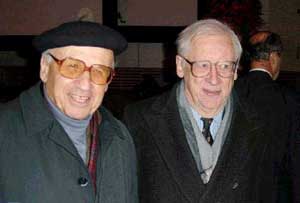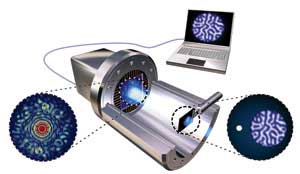 |
|
John Pople & Walter Kohn |
Born in 1925 in Burnham-on-Sea, Somerset (England), John Pople earned his Ph.D. in mathematics in 1951 from the University of Cambridge. A year later, he developed a formula for a basic scheme to create mathematical models for molecular research without the need for experimental procedures.
After leading the Basic Physics Research Centre at the UK National Physical Laboratory near London for some time, he quickly realized that he was not suited for spending too much time on management tasks, which led him to emigrate to the United States in 1958.
In 1964, Pople became a professor of physical chemistry at Carnegie Tech, which later became Carnegie Mellon University in Pittsburgh (USA). He was knighted by Queen Elizabeth II in 2002 for his contributions to chemical research. In 1986, he moved to the Department of Chemistry at Northwestern University (USA).
John Pople, who won the Nobel Prize in 1998 for his significant contributions to the development of computational methods in chemistry, passed away on March 15, 2004, at his home at the age of 78 due to liver cancer.
 Pople developed computational techniques for examining and determining the chemical structure and details of matter. The computer programs he developed have been utilized by thousands of universities and businesses worldwide. By the 1990s, he revised this program, integrating it with the density theory of Walter Kohn, who shared the Nobel Prize in Chemistry with him. Kohn was an Austrian scientist working at the University of California, Santa Barbara (USA). His research, starting in the 1960s, simplified the mathematical description of the bonding between atoms that form molecules.
Pople developed computational techniques for examining and determining the chemical structure and details of matter. The computer programs he developed have been utilized by thousands of universities and businesses worldwide. By the 1990s, he revised this program, integrating it with the density theory of Walter Kohn, who shared the Nobel Prize in Chemistry with him. Kohn was an Austrian scientist working at the University of California, Santa Barbara (USA). His research, starting in the 1960s, simplified the mathematical description of the bonding between atoms that form molecules.
Pople’s computational approach to chemistry enabled scientists to create computer models of many chemical reactions, which are often impossible or very difficult to replicate in laboratory settings. His work has broad applications, from assisting in the study of stars based on chemical signatures measured through telescopes to investigating how pollutants like freon interact with the ozone layer. In the medical field, researchers also utilized Pople’s computational quantum chemistry methods to recreate the effects of certain anti-infective drugs for HIV.


















































